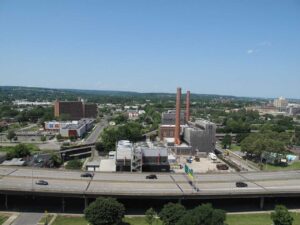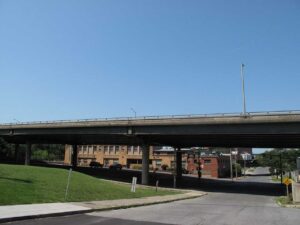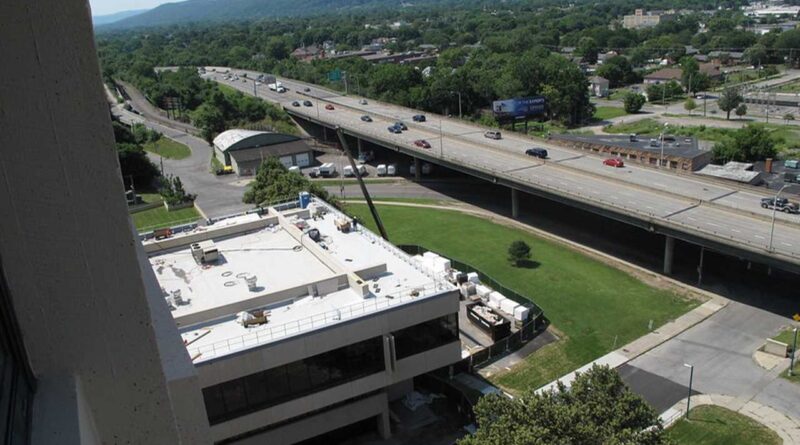I-81 Viaduct Speed Limit
by Miguel Balbuena
A review of the mission statements or priorities of law enforcement agencies from the state level down to the local ones finds that a duty of the New York State Police is “to prevent and detect crime and violations of law;” of the Onondaga County Sheriff’s Office Police Department is to “enforce all laws,” and; of the Syracuse Police Department is to “enforce the laws.”
 There are instances in which these agencies’ functions overlap. A case in point is the portion of the Interstate 81 highway that runs through the Salt City for 12 miles, 1.4 of them as an elevated piece of aging grey infrastructure. Roughly 57 percent of this viaduct abuts upon the South Side neighborhood, mostly on the Pioneer Homes housing development. This situation allows the state police to intervene in Syracuse “to ensure the safety of the state’s roadways,” such as I-81, while this highway is within the geographical jurisdiction of the sheriff’s deputies as Syracuse sits within Onondaga County.
There are instances in which these agencies’ functions overlap. A case in point is the portion of the Interstate 81 highway that runs through the Salt City for 12 miles, 1.4 of them as an elevated piece of aging grey infrastructure. Roughly 57 percent of this viaduct abuts upon the South Side neighborhood, mostly on the Pioneer Homes housing development. This situation allows the state police to intervene in Syracuse “to ensure the safety of the state’s roadways,” such as I-81, while this highway is within the geographical jurisdiction of the sheriff’s deputies as Syracuse sits within Onondaga County.
On July 16 the New York State Department of Transportation (NYSDOT) and the Federal Highway Administration released their long-expected Draft Environmental Impact Statement (DEIS), the official name of their plan on the future of the I-81 viaduct.
“Field travel times and vehicular speeds were collected in December 2013 along 11 routes within the Project Area,” the DEIS says in its chapter 5, on transportation considerations. “Data was collected using the average-car method, where a vehicle is driven along the route traveling with traffic at prevailing speeds while distance, travel time, and delay are recorded. Travel time and delay surveys were conducted during the A.M. (7:00 to 9:00 A.M.) and P.M. (4:00 to 6:00 PM) peak periods.”
“Average travel speeds on the freeways throughout the project area range from approximately 55 to 66 miles-per-hour (m.p.h.) for the A.M. peak hour and from 55 to 63 m.p.h. in the P.M. peak hour. For most freeway routes, the AM peak hour travel speeds are similar to the PM peak hour speeds,” the document goes on to say.
On Aug 18 the NYSDOT hosted two in-person public hearings on the I-81 viaduct project at the Nicholas Pirro Convention Center. Staffing an informative station set along both hearings was Justin Kellogg, a licensed civil and structural engineer consulting for this state department. He said that in its calculations forecasting the noise pollution to be generated by traffic on the elevated portion of I-81, the NYSDOT did not use the posted speed limit of 45 m.p.h. on this portion because this would unrealistic as no driver complies with it. He added that, instead, the NYSDOT utilized an average one of 62 m.p.h., which is more consistent with the data collected by it.
Even the latter speed is an understatement. I travel frequently on the viaduct and there I consistently see motorists flouting the law by driving their vehicles at about 70 miles per hour on the right lane and 80 miles per hour on the left lane. We know that speed levels are positively correlated with noise levels. Notorious lack of enforcement of speed limits on the part of the New York State Police, the Onondaga County Sheriff’s Office Police Department and the Syracuse Police Department, all three charged with doing so, is leading to a lack of compliance of these limits on the part of the drivers. If there is a law in the books that is not being enforced, it is the same thing as a law not being in existence. Some neighbors think this situation constitutes legally a dereliction of duty. The fact of the matter is that this negligence is causing the health of the residents of this part of the South Side to get deteriorated to benefit the convenience of drivers on I-81, who do not have to pay the price of the noise pollution that they create because it gets discharged to South Side residents. It fits the classic example of transfer of negative externalities from commuters to neighbors.
their vehicles at about 70 miles per hour on the right lane and 80 miles per hour on the left lane. We know that speed levels are positively correlated with noise levels. Notorious lack of enforcement of speed limits on the part of the New York State Police, the Onondaga County Sheriff’s Office Police Department and the Syracuse Police Department, all three charged with doing so, is leading to a lack of compliance of these limits on the part of the drivers. If there is a law in the books that is not being enforced, it is the same thing as a law not being in existence. Some neighbors think this situation constitutes legally a dereliction of duty. The fact of the matter is that this negligence is causing the health of the residents of this part of the South Side to get deteriorated to benefit the convenience of drivers on I-81, who do not have to pay the price of the noise pollution that they create because it gets discharged to South Side residents. It fits the classic example of transfer of negative externalities from commuters to neighbors.
Miguel Balbuena is a writer in the academic, scientific, journalistic and literary fields (in the fiction and non-fiction genres).
Photos provided by Miguel Balbuena

